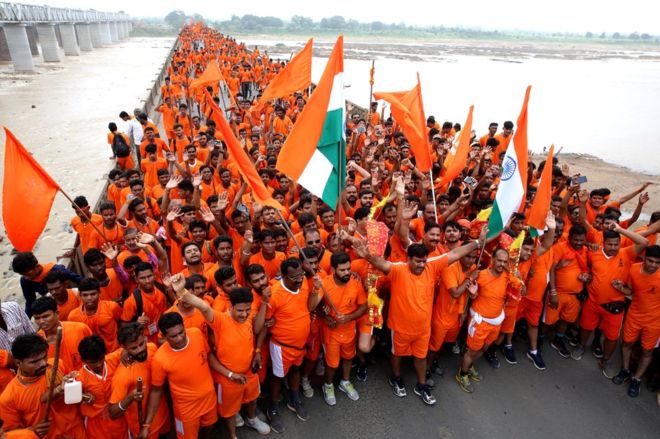Kanwariya Yatra is a ritual to pay obeisance to Lord Shiva, during the months of July-August (Shravan-maas in Hindi calendar), by the people of northern states of Rajasthan, Haryana, Uttaranchal and Uttar Pradesh. This year’s journey, which has now begun, is named after the Sanskrit word ‘Kanvar’ which is a single pole (usually bamboo) with two roughly equal loads dangling from both ends.
During these times, one can see a teeming population of Kanwariya pilgrims, garbed in saffron clothings and carrying pots of holy water that they have collected from either Gaumukh or Gangotri (Uttaranchal) or from the Ganges in Haridwar and returning back to their respective hometowns in order to consecrate the shiva lingams.
Though Kanwarya yatras have long history but it has been gaining a lot of significance over the last few years as the devotees have increased in numbers. From 55 lakh pilgrims in 2003, the figure touched 3.79 crores last year and is expected to cross 4 crore mark this year. And holy visitors from distant states like Madhya Pradesh, Bihar, Jharkhand and Chhattisgarh have also started joining in lately. “This time we expect a bigger number,” Director General, Uttarakhand, wrote to Delhi Police chief on June 26.
Anticipating a huge turnout, the UP and Delhi governments have started making elaborate arrangements. Over 225 camps in Delhi have been constructed for kanwarias, looking after their food and rest facilities. Along with this, there is a joint collaboration of state governments and Centre providing drones for aerial surveillance, petal showers from choppers, extra police deployment, water tankers and mobile toilets. In Delhi, 173 camps hs been set up apart from 50-plus camps built by private organisations. A private camp owner Shyam Sundar said, “In 2006, Delhi had 19 camps, and now it’s 225.” After camps are set up, samitis run by area pradhans provide the food — three meals, tea, biscuits etc.
For the first time there is a provision of registration of kanwars, first at their villages and then at check posts. This will curb hooliganism, created by a few miscreants in garb of religious followers and the whole yatra’s reputation got maligned. DCP (East) Jasmeet Singh said, “We have asked organisers to give ID cards to kanwars… this will deter anyone from being mischievous and will keep a check on anti-social elements.” Special CP (Traffic) Taj Hassan said “separate passage for their movement using barricades and ropes has been created”.
Elaborating the travel behavior of the ‘yatris’, Uttarakhand DG explained that in the first phase, kanwars walk, but on the last five-six days, “they use trucks or trolleys to reach home early for jal-abhishek, and compete on the road… this can cause accidents or fighting or an act against an unsuspecting local”. He also cautioned about “sound systems which can cause accidents” and “dak kanwars”.
Dak kanwars is a new pattern where Shiv-bhakts run with several pots, relaying them to the next person every one km. The DG wrote about how they may carry some rustic arsenal like “hockey sticks, trishul, cricket and baseball bats and in past it has been seen that the Kanwars become violent if someone challenges them”. Adopting a strict posture, he warned the unruly elements that the at the Haridwar border, weapons and sound systems will be seized but “the numbers are such that there is always a risk…”
Elaborate security arrangements have been initiated this year. Said Rupendra Dutt Sharma, Haridwar’s chief education officer, “from July 23-30, schools, colleges and anganwadi centres will be closed”. After the successful hosting of the biggest ever event of Kumbh Mela, the Yogi Adityanath administration in UP has upped the arrangements. Around 8,000 security personnel, including Rapid Action Force and BSF, ATS units, snipers on the pattern of Kumbh Mela, drones and helicopters for aerial surveillance, and showering of rose petals.
“We have sent a request to UP government… we are hopeful the helicopters will come to Meerut by July 25,” said Sanjeev Bajpai, SP Traffic (Meerut). There is also a plan to shower devotees with rose and marigold petals from July 26 onwards. “We will need five tonnes (5,000 kg) of petals, at a cost of Rs 20 lakh,” said an official. A senior official said they expect the cost of helicopters to go up: “This year it will cost roughly Rs 17 lakh for three-four days.”
This annual tradition of the Kanwariya Yatra is acquiring a new dimension. With devotees crossing 4 crore mark, these is an opinion that the Kanwariya yatra should be treated at par with the pilgrimages of Kailash Mansarovar or Amarnath yatra. Since the number of the pilgrims is inflating with each passing year, the recognition of this yatra as national pilgrimage would arm it with certain administerial provisions where sound logistical arrangement and security arrangements could be automatically provided and onus would no more be on local citizens and volunteer organizations.
According to the age old traditions of this yatra, the pot filled with ‘Ganga-jal’ should not touch the ground before the consecration of the lingam. For this a lot of charitable organizations have placed special kanwar stands along the way. Various voluntary organizations that have also put up medical and food stalls for the kanwarias for their well-being.


